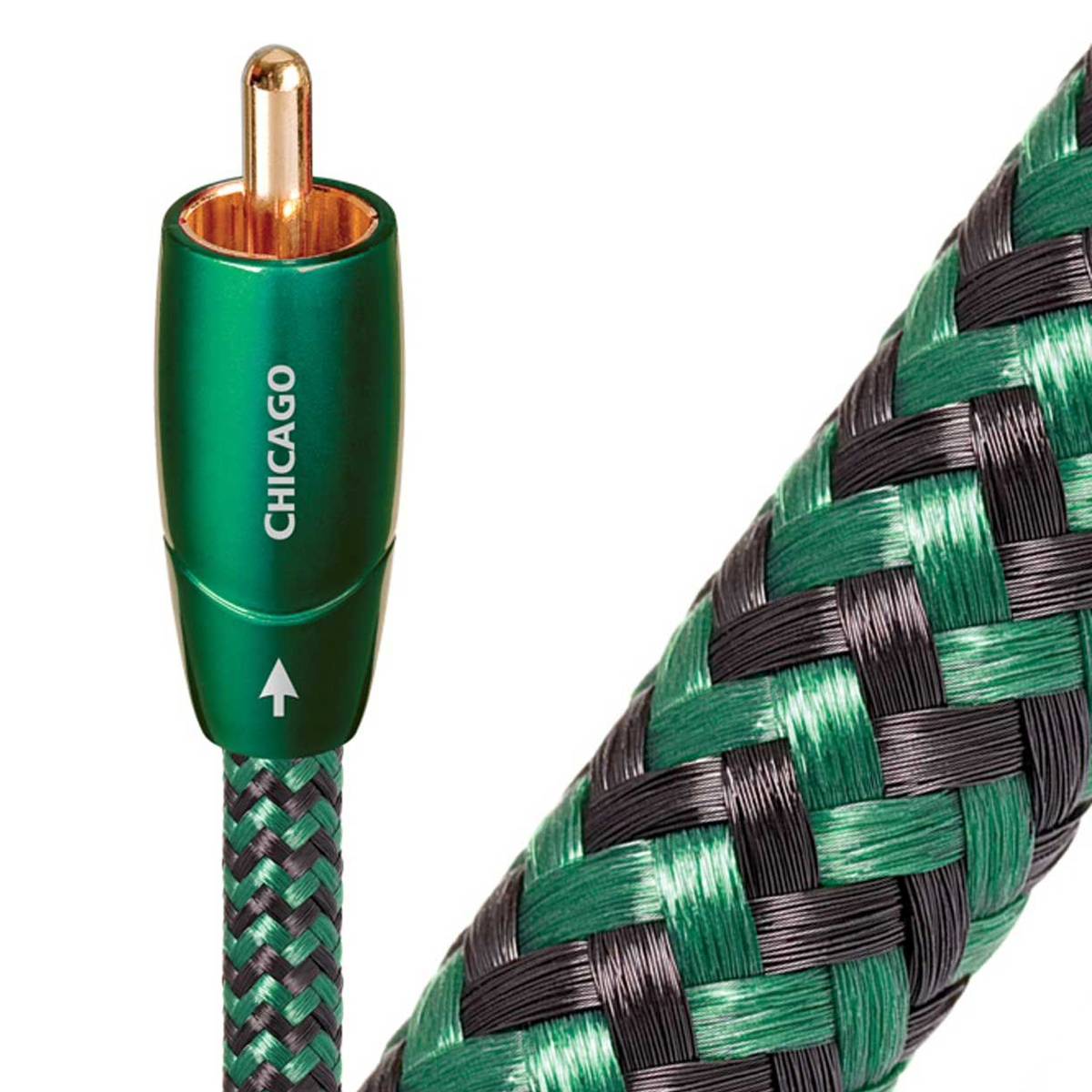


AudioQuest Chicago - RCA-RCA Cable - Pair
Includes GST of Rs. 1,922

GET GST INPUT
Ever wondered why speakers, amplifiers, projectors etc. come with a slightly heftier price tag in India compared to their overseas counterparts? Well, part of the answer lies in our country's Goods & Services Tax (GST).
But here's the kicker: Don't let that GST input slip through your fingers! Especially when some of the products we supply carry a GST rate of 18% and 28%.
At AVStore, we provide you with a GST compliant invoice for every purchase.
Simply put in your GST number during the checkout to avail an offset.

- Description
- Specifications
- Reviews
CHICAGO RCA-RCA
AudioQuest Chicago RCA cables is the entry-level RCA-RCA cable offering from the brand but make no mistake, they are leaps and bounds better in performance than your regular run of the mill RCA-RCA cables. Bring the fidelity your music deserves to life with the AudioQuest Chicago RCA-RCA interconnect.
METAL-LAYER NOISE-DISSIPATION
It's easy to accomplish 100% shield coverage. Preventing captured radio-frequency interference (RFI) from modulating the equipment's ground reference requires AQ's Noise-Dissipation. Traditional shield systems typically absorb and then drain noise/RF energy to component ground, modulating and distorting the critical "reference" ground plane, which in turn causes a distortion of the signal. Noise-Dissipation "shields the shield," absorbing and reflecting most of this noise/RF energy before it reaches the layer attached to ground.
HARD-CELL FOAM INSULATION
Hard-Cell Foam (HCF) Insulation ensures critical signal-pair geometry. Any solid material adjacent to a conductor is actually part of an imperfect circuit. Wire insulation and circuit board materials all absorb energy. Some of this energy is stored and then released as distortion. Hard-Cell Foam Insulation is similar to the Foamed-PE used in AudioQuest's more affordable Bridges & Falls cables, and is nitrogen-injected to create air pockets. Because nitrogen (like air) does not absorb energy and therefore does not release any energy from or into the conductor, distortion is reduced. In addition, the stiffness of the material allows the cable's conductors to maintain a stable relationship along the cable's full length, producing a stable impedance character and further minimizing distortion.
DOUBLE-BALANCED GEOMETRY
Specifically designed for single-ended applications, Double-Balanced Geometry offers a relatively lower impedance on the ground for a richer and more dynamic experience. While many single-ended cable designs use a single path for both the ground and the shield, Double-Balanced designs separate the two for cleaner, quieter performance.
COLD-WELDED, GOLD-PLATED TERMINATIONS
This plug design allows for a connection devoid of solder, which is a common source of distortion. Instead of solder, the process employs a high-pressure technique. Because the ground shells are stamped instead of machined, the metal used can be chosen for low distortion instead of machinability.
SOLID LONG-GRAIN COPPER (LGC) CONDUCTORS
Solid Long-Grain Copper (LGC) allows a smoother and clearer sound than cables using regular OFHC (Oxygen-Free High-Conductivity) copper. Solid conductors prevent strand interaction, a major source of distortion. The surface quality is critical because a conductor can be considered as a rail-guide for both the electric fields within a conductor, and for the magnetic fields outside the conductor. LGC has fewer oxides within the conducting material, less impurities, less grain boundaries, and definitively better performance.
CHICAGO RCA-RCA
AudioQuest Chicago RCA cables is the entry-level RCA-RCA cable offering from the brand but make no mistake, they are leaps and bounds better in performance than your regular run of the mill RCA-RCA cables. Bring the fidelity your music deserves to life with the AudioQuest Chicago RCA-RCA interconnect.
METAL-LAYER NOISE-DISSIPATION
It's easy to accomplish 100% shield coverage. Preventing captured radio-frequency interference (RFI) from modulating the equipment's ground reference requires AQ's Noise-Dissipation. Traditional shield systems typically absorb and then drain noise/RF energy to component ground, modulating and distorting the critical "reference" ground plane, which in turn causes a distortion of the signal. Noise-Dissipation "shields the shield," absorbing and reflecting most of this noise/RF energy before it reaches the layer attached to ground.
HARD-CELL FOAM INSULATION
Hard-Cell Foam (HCF) Insulation ensures critical signal-pair geometry. Any solid material adjacent to a conductor is actually part of an imperfect circuit. Wire insulation and circuit board materials all absorb energy. Some of this energy is stored and then released as distortion. Hard-Cell Foam Insulation is similar to the Foamed-PE used in AudioQuest's more affordable Bridges & Falls cables, and is nitrogen-injected to create air pockets. Because nitrogen (like air) does not absorb energy and therefore does not release any energy from or into the conductor, distortion is reduced. In addition, the stiffness of the material allows the cable's conductors to maintain a stable relationship along the cable's full length, producing a stable impedance character and further minimizing distortion.
DOUBLE-BALANCED GEOMETRY
Specifically designed for single-ended applications, Double-Balanced Geometry offers a relatively lower impedance on the ground for a richer and more dynamic experience. While many single-ended cable designs use a single path for both the ground and the shield, Double-Balanced designs separate the two for cleaner, quieter performance.
COLD-WELDED, GOLD-PLATED TERMINATIONS
This plug design allows for a connection devoid of solder, which is a common source of distortion. Instead of solder, the process employs a high-pressure technique. Because the ground shells are stamped instead of machined, the metal used can be chosen for low distortion instead of machinability.
SOLID LONG-GRAIN COPPER (LGC) CONDUCTORS
Solid Long-Grain Copper (LGC) allows a smoother and clearer sound than cables using regular OFHC (Oxygen-Free High-Conductivity) copper. Solid conductors prevent strand interaction, a major source of distortion. The surface quality is critical because a conductor can be considered as a rail-guide for both the electric fields within a conductor, and for the magnetic fields outside the conductor. LGC has fewer oxides within the conducting material, less impurities, less grain boundaries, and definitively better performance.


